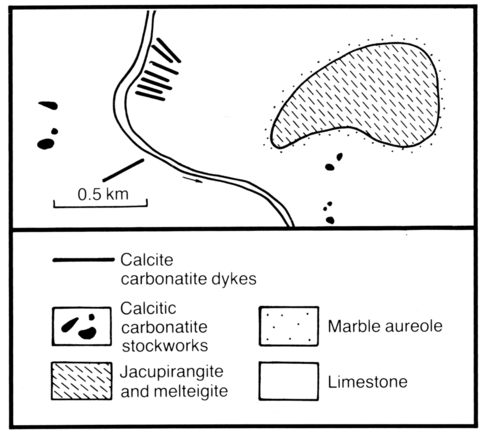stripes
The Changit intrusion is situated 20 km southwest of Romanikha and was discovered by P.S. Fomin in 1943 and studied by Egorov and Surina (1961). The country rocks are limestones of upper Cambrian and Ordovician age. The intrusion is composed essentially of jacupirangite, melteigite and olivine melanephelinite of variable texture and composition. The main components are augite and titanaugite (30-90%), nepheline (up to 35%), biotite, titanomagnetite, olivine and minor titanite, perovskite, aegirine-augite, apatite, K-feldspar and phlogopite. The feldspathoidal rocks contain schlieren of melilitic rocks including turjaite and nepheline uncompahgrite, which are composed mainly of melilite, pyroxene, nepheline and olivine. Close to Changit are some small (from a few to tens of metres diameter) stock-like bodies and dykes of carbonatite and peralkaline syenites.
BUTAKOVA, E.L. and EGOROV, L.S. 1962. The Meimecha-Kotui complex of formations of alkaline and ultrabasic rocks. In Petrography of Eastern Siberia. 1: 417-589. Izd-vo AN SSSR, Moscow.
EGOROV, L.S. 1969. The melilite rocks of the Maimecha-Kotui province. Nedra, Leningrad. 247 pp.
EGOROV, L.S. and SURINA, N.P. 1961. The carbonatites of the Changit intrusive at the north of the Siberian platform. Trudy Nauchno-Issledovatel'skogo Instituta Geologii Arktiki, Leningrad, 125: 160-78.

